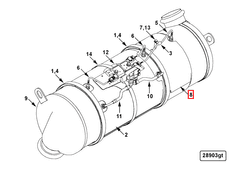This truck part is made by Cummins®. We guarantee that all of our parts are from the OEM (original equipment manufacturer), ensuring a proper fit and quality manufacturing.
We honor the warranty provided by the original equipment manufacturer.
Introduction
The Cummins 2880516 Inlet Catalyst Module is designed for heavy-duty trucks to enhance exhaust system efficiency and reduce harmful emissions. It integrates into the truck’s exhaust system, working with other components to improve engine performance and meet emissions standards.
Basic Concepts
The Inlet Catalyst Module catalyzes the conversion of harmful exhaust gases into less harmful substances. It interacts with exhaust gases using a catalyst to promote chemical reactions that reduce pollutants like nitrogen oxides (NOx) and particulate matter, which is essential for environmental compliance and air quality improvement 1.
Purpose and Function
This Cummins part significantly contributes to the truck’s exhaust system by reducing emissions and enhancing engine performance. Positioned upstream, it treats exhaust gases immediately after they leave the engine, catalyzing pollutant conversion for a cleaner exhaust output and maintaining engine efficiency and power 2.
Key Features
The Inlet Catalyst Module features a robust design to withstand high temperatures and pressures. Constructed with durable materials, it ensures longevity and reliability. Its compact size and efficient catalyst formulation enhance performance, making it effective in emission reduction 3.
Benefits
The module offers improved fuel efficiency, reduced emissions, and enhanced engine longevity. By optimizing the exhaust process, it allows the engine to operate more efficiently, leading to fuel consumption savings. Its role in reducing emissions contributes to environmental sustainability and extends vehicle lifespan 4.
Installation Process
Proper installation of the Inlet Catalyst Module involves ensuring the exhaust system is clean and free of obstructions. It should be secured in its designated position within the exhaust path, with all connections tight and sealed to prevent leaks. Following manufacturer guidelines is crucial to maintain the integrity of the exhaust system.
Maintenance Tips
Regular maintenance is recommended to ensure optimal performance of the Inlet Catalyst Module. This includes periodic inspection for wear or damage and cleaning the module as necessary to remove any buildup that could impede its function. Adhering to recommended service intervals will help maintain the efficiency of the exhaust system and the overall performance of the truck.
Troubleshooting Common Issues
Common issues with the Inlet Catalyst Module may include reduced efficiency due to contamination or physical damage. Troubleshooting involves inspecting the module for visible damage, checking for proper installation, and ensuring there are no obstructions in the exhaust system. If issues persist, consulting the manufacturer’s guidelines or a professional technician is advised.
Cummins Overview
Cummins Inc. is a global leader in power solutions, including engines, filtration, and emissions solutions. With a commitment to innovation and sustainability, Cummins designs products to meet the demanding requirements of various industries, ensuring a more efficient and environmentally friendly future.
Role of Part 2880516 Inlet Catalyst Module in Aftertreatment Systems
The 2880516 Inlet Catalyst Module is integral to the aftertreatment system of modern engines, strategically positioned to enhance emissions control efficiency. Exhaust gases, after passing through the turbocharger, are directed towards this module, where preliminary chemical reactions reduce harmful emissions. These reactions, facilitated by the catalyst materials within the module, convert pollutants into less harmful substances.
Following its passage through the Inlet Catalyst Module, the exhaust moves to the Diesel Oxidation Catalyst (DOC), where further reduction of carbon monoxide (CO) and hydrocarbons (HC) occurs. The DOC works in conjunction with the Inlet Catalyst Module to ensure the exhaust is sufficiently treated before reaching the Selective Catalytic Reduction (SCR) system.
In the SCR system, ammonia is introduced to the exhaust stream to convert nitrogen oxides (NOx) into nitrogen (N2) and water (H2O). The efficiency of the SCR system is enhanced by the preliminary treatment provided by the Inlet Catalyst Module, ensuring the exhaust is in an optimal state for the final stages of emissions reduction.
Overall, the 2880516 Inlet Catalyst Module significantly contributes to the aftertreatment process, enhancing the system’s effectiveness in meeting stringent emissions regulations.
Conclusion
The Cummins 2880516 Inlet Catalyst Module is a vital component in the exhaust systems of heavy-duty trucks, playing a crucial role in reducing emissions and enhancing engine performance. Its integration into the aftertreatment system ensures compliance with environmental regulations and contributes to a cleaner, more sustainable future.
-
Halderman, James D. Automotive Principles: Diagnosis and Service. Prentice Hall, 2012.
↩ -
Watson, Ben. Mobile Equipment Hydraulics A Systems and Troubleshooting Approach. Cengage Learning, 2011.
↩ -
Hilgers, Michael. Transmissions and Drivetrain Design. Springer Vieweg, 2022.
↩ -
Bennett, Sean. Modern Diesel Technology: Light Duty Diesels. Cengage Learning, 2012.
↩
SPECIFICATIONS
RECOMMENDED PARTS
* Variable geometry turbocharger and electronic actuator repairs are not eligible to be claimed as over-the-counter under New or ReCon parts warranty for parts installed after October 1, 2018.
* Diesel Oxidation Catalyst (DOC), Diesel Particulate Filter (DPF), Selective Catalyst Reduction (SCR) catalyst, and Electronic Control Module (ECM) repairs are not eligible to be claimed as over-the-counter under New or ReCon parts warranty for parts installed after January 1, 2020.
* These restrictions are only applicable to New parts and ReCon parts coverages for the components listed above sold to a customer in the US or Canada. All other coverages are excluded. All other regions are excluded.

